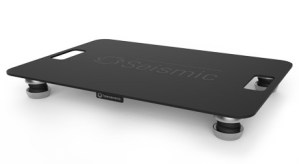
A few years back I discovered something wonderful about the Seismic Sink I was using under my turntable to control vibration.
In our experience, vibration control is one of the most important revolutionary advancements in audio of the last twenty years or so.
We sell the Seismic Sink and this is what I wrote to a customer who recently bought one:
Play your most complex test discs, the ones that are the hardest to get to sound right. Classical is the toughest test if you have some, but Pet Sounds is tough too. [I knew he was a fan and had a good copy of the album.]
Listen to one or two for a good while, at least 20-30 minutes, to know exactly what you are hearing on the tracks you know are the most difficult to get to sound right, the ones with the most problems.
Put the sink under the table. (You can also put it under your receiver, that works great too.)
Then play those tracks again.
Go back and forth a few times.
It should be pretty obvious what is going on.
Then read Robert Brook’s post.
Here is a very special tip.
The sound changes depending on how the seismic sink is “loaded.”
This means two things:
Where the weights are sitting on the sink.
For my integrated amp I have it all the way to the front of the sink. Sounds clearly better that way.
For the turntable, I have it weighted down with thin but heavy steel plates, about one quarter inch thick, about 4 inches by 8 inches. You can get them at Home Depot and similar places.
This may be too advanced for your system and your skills [not an insult, he knows he is new to the game], but any amount of weight changes the sound, so you keep adding weights until you get to the top of the hill and start heading down.
Sounds easy enough, takes a lot of critical listening to pull it off, but this is how your ears get good at hearing small changes.
Good luck.
Best, TP
PS
This commentary should help give your tweaking efforts more context.
Further Reading